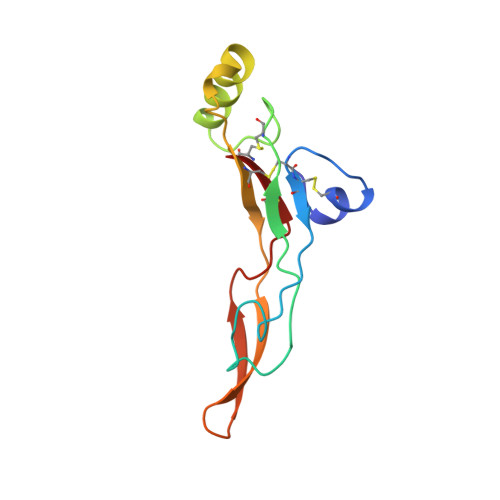The crystal structure of TGF-beta 3 and comparison to TGF-beta 2: implications for receptor binding.
Mittl, P.R., Priestle, J.P., Cox, D.A., McMaster, G., Cerletti, N., Grutter, M.G.(1996) Protein Sci 5: 1261-1271
- PubMed: 8819159
- DOI: https://doi.org/10.1002/pro.5560050705
- Primary Citation of Related Structures:
1TGJ, 1TGK - PubMed Abstract:
Transforming growth factors beta belong to a group of cytokines that control cellular proliferation and differentiation. Five isoforms are known that share approximately 75% sequence identity, but exert different biological activities. The structure of TGF-beta 3 was solved by X-ray crystallography and refined to a final R-factor of 17.5% at 2.0 A resolution. Comparison with the structure of TGF-beta 2 (Schlunegger MP, Grütter MG, 1992, Nature 358:430-434; Daopin S, Piez KA, Ogawa Y, Davies DR, 1992, Science 257:369-373) reveals a virtually identical central core. Differences exist in the conformations of the N-terminal alpha-helix and in the beta-sheet loops. In TGF-beta 3, the N-terminal alpha-helix has moved approximately 1 A away from the central core. This movement can be correlated with the mutation of Leu 17 to Val and Ala 47 to Pro in TGF-beta 3. The beta-sheet loops rotate as a rigid body 9 degrees around an axis that runs approximately parallel to the dimer axis. If these differences are recognized by the TGF-beta receptors, they might account for the individual cellular responses. A molecule of the precipitating agent dioxane is bound in a crystal contact, forming a hydrogen bond with Trp 32. This dioxane may occupy a carbohydrate-binding site, because dioxane possesses some structural similarity with a carbohydrate. The dioxane is in contact with two tryptophans, which are often involved in carbohydrate recognition.
Organizational Affiliation:
Ciba-Geigy Ltd., Pharmaceutical Research, CH-4002 Basle, Switzerland.














